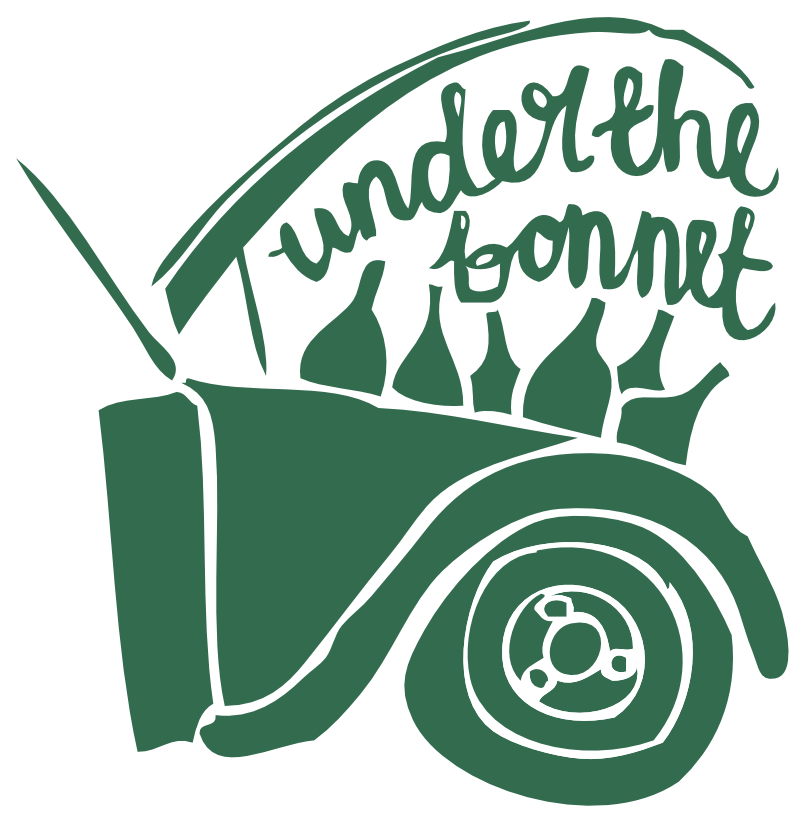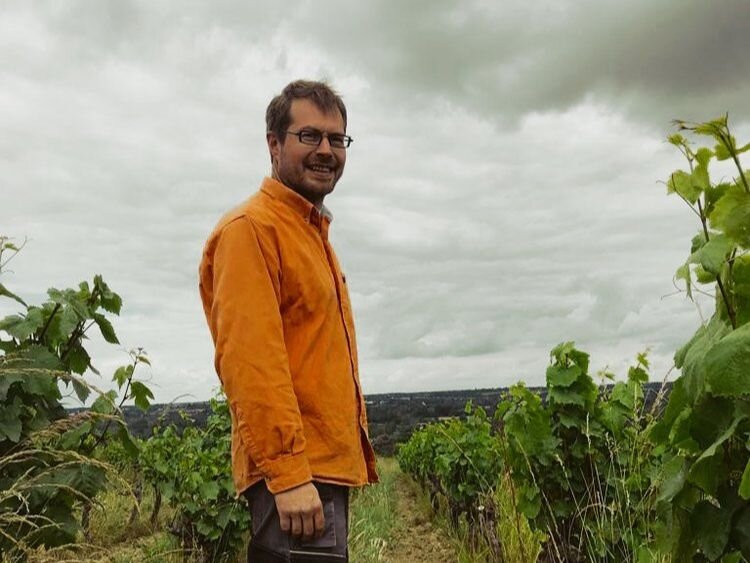We love a delivery from Thomas Boutin. We've just received two vintages of three cuvees that he refines each year with careful consideration, and a small quantity of his 2011 botrytised Chenin, Topaze. We spoke with Thomas recently about the 2019 iterations of some of our favourite Anjou wines, and how the last 12 months have been…
Read moreAnjou Glad You Called?
Domaine Les Goelands - Philippe Delmee
France, Loire, Anjou
We’re lucky to work with a brace of amazing growers across that special pocket of the Loire: Anjou. Home-turf for the majority of the Cabernet Franc we import, we’re still surprised at the variations from grower to grower.
Threatening to trip clumsily into ‘dogs who look like their owners’ territory here, but Cab Franc is a grape that really can reflect the personality of its handler. No surprise then that Philippe Delmee’s expressions have a sense of play, with an underlying serious edge.
In addition to the Grolleau and Chenin planted in Faye d’Anjou, Phil’s Cabernet Franc is spread over five hectares of closely knit plots around Faveryae-Machelles; all planted on poor sand and schist soils.
We’ve just received his three different expressions of Cab Franc from this one small region, each bringing another side to the table.
Oppidum Rouge 2018
“The plot for this new single vineyard cuvee is about 5 hectares, it's on the site of an old oppidum- a Roman camp from when they occupied Gaul. It's a mix of de-stemmed cabernet franc and whole bunch cab franc, fermented using semi-carbonic maceration.”
A softer, ripe blackcurrant-packed cuvee. The label is a nod to how they would’ve enjoyed wine at the oppidum. No amphora here!
Ca Faye Douze 2019
“Like always, this is whole-bunch, carbonic Cabernet Franc. There's a little gas this year because I bottled it with around 1 gram of sugar, so there is a brief fermentation in the bottle after. No sulphites added.”
Beautiful this year: fresh, crunchy, and with that friendly little spritz to kick things off. This is perfect bistro wine: bring me a plastic tablecloth, paté and baguette please. Empties very quickly.
Les Vieux de la Vielle 2017
“Part de-stemmed cabernet franc, using semi-carbonic maceration. A mix of whole and broken berries, a very gentle maceration overall. The tank I used for fermentation is a new open-top wooden one, it's in there for 8 days, very short. But it's very good!”
A stylistic shift for Philippe this year, fermented and aged in wood, which he usually reserves for his whites. A deeper, more complex expression than Ca Faye Douze & Oppidum.
We have limited quantities of these at the moment, but if all goes to plan on the roads of Anjou, more will be arriving in the next couple of weeks. Phil doesn’t own a forklift, and having just sent one pallet to us, he’s busy shuttling the next one car load by car load, up the road to his friends at Le Grange Aux Belles to be shipped out soon.
For wholesale price lists please email hello@winesutb.com
From Anjou with Love
Thomas Boutin
France, Loire, Anjou, Rochefort-sur-Loire, Angers
Now finally back in stock: 2018 Charabia, Celsiane and La Quillette. We've had a quick chat with Thomas:
"2018 has been difficult but with a good result. We've had loads of rain in June which caused mildew. It stopped in July and the heat allowed us to fight the mildew, which then resulted in a good harvest both quality and quantity wise."
"As for the 2018 cuvees, there were a couple of changes. For example for Charabia, which is normally 100% Chardonnay, I have added 15% of Chenin, to make the wine more round. For La Quillette I have upped the Grolleau percentage from 5% to 20%, to add more peppery and spicy notes. In general what happened was that my yield has generally doubled, it went from 13 hl/ha in 2017 to 30 hl/ha in 2018."
"Each wine has a name for a reason: La Quillette means 'la petite bouteille' - 'the small bottle'. This stands for a wine which is very easy to drink and quick to finish, it is overall a light and fruity wine.”
”La Charabia stands for a person who doesn't make sense when they talk: 'tu fait du Charabia' - 'you are talking nonsense'. As this is again a very easy drinking wine, so 'Charabia' is basically what happens as the end result.
Celsiane is a name of a rare tulip which grows near Coteaux du Layon, and I have chosen this name as a homage to my parents and grandparents who were all working in agriculture, same as me before I started making wines. This particular tulip is also often planted in between the vines of biologically farmed vineyards is order to help cultivate them."
"This year so far we were lucky and we haven't had any frost or mildew. It is looking rather hot already, so I'm planning to harvest around the 23rd/ 24th of August. Which means about 2 weeks earlier than last year. Let's see where this takes us!"
Now in Stock
WHITE
2018 Charabia - Chardonnay (85%), Chenin (15%)
Manual harvest. Direct pressing. Vinification with natural yeasts. Aged in vats, on the lees for 10 months. Unfiltered, racked before bottling.
2018 Celsiane - Chenin
Manual harvest. Direct pressing. Vinification with natural yeasts. Aged in vats, on the lees for 11 months. Unfiltered, racked before bottling.
RED
2018 La Quillette - Gamay (60%), Cab Franc (20%) & Grolleau (20%)
Manual harvest. Direct pressing. Vinification with natural yeasts. Whole bunch maceration for 8 days in vats. Separate maceration and vinification for all grape varieties. Aged in vats, on the lees for 9 months. Unfiltered, racked before bottling.
WHOLESALE ONLY
FOR PRICE LIST ENQUIRIES, EMAIL hello@winesutb.com
A Chat With Thomas Boutin
Thomas Boutin
France, Loire, Anjou, Rochefort-sur-Loire, Angers
Thomas Boutin started his own winemaking project in 2008, with only 1.8 hectares. In 2011, he inherited a compact winery and vines from his mentor, and has progressively built up the number of hectares. He farms two hectares in Rochefort-sur-Loire and one hectare in Saint Aubin. He is evolving as a winemaker, and experiments whilst learning and finding his style.
Having studied oenology and worked in larger wineries, he is passionate to keep the approach small-scale with minimal intervention. All wines are made without any use of chemicals, are unfined and unfiltered with little use of sulfur.
Tell us about your 2018 harvest: What were your challenges? What went particularly well?
2018 has been difficult but with a good result. We've had loads of rain in June which caused mildew. It stopped in July and the heat allowed us to fight the mildew, which then resulted in a good harvest both quality and quantity wise.
What do you anticipate for the 2019 harvest?
I always wait until September to have a better idea of the end result. August is a really important month when it comes to maturity of the wines. For the moment what I can see is that the buds are developing well from the outside, but I cannot tell yet how good the quality is.
What is your personal favourite vintage you have made to date and why?
I have two: 2012 and 2016 when it comes to quality, even though the yield was very small. I haven't made loads of money but the wines turned out amazing.
Which wines do you enjoy drinking besides your own?
Normally I enjoy drinking full-bodied wines but at the moment I drink light reds. There is no particular region that I prefer, I am more about discovering new wines, especially from outside of France.
Are there any winemakers whose influence has been particularly important?
Benoît Landron has helped me out immensely. We enjoy sharing our wines and I will always be helpful to him as he has helped me to establish myself as a winemaker.
Also, there are other winemakers who have taught me a lot and who are less into natural wines but are still organic certified. For example Benjamin Delobel. There are always more things to learn as there are always new challenges coming up.
What can you tell us about your future plans?
I want to reduce the use of copper in the vineyard. Also, I want to create a new cuvée. At first I thought about using barrels but now I feel like I am at a point where I'm more connected with the earth and I want to try making a cuvée using amphora.
Further down the road I'd like to plant Pinot d'Aunis and Grolleau Gris and have some fun experimenting making new cuvées.
Now in stock
White
NEW 2017 Celsiane - Chenin
"100% chenin, from five different plots. Two plots consist of 60-70 year old vines, planted after the second world war in mass selection. The other three are between 20-30 years old in clonal selection: one with coarse grains and normal maturity, the second one with very early coarse grains, I sometimes pick it up a week ahead of the other vines, and the last with small grains and a normal maturity. The fermentation took place over one year. This wine has a fresh mouth, very ripe fruit, almost dry fruit with hints of honey. Warm notes of plum which remind of Alsatian wines and give the wine a bit of pep."
2016 Charabia - Chardonnay
"Small yield due to frost (loss of 5 - 10%) mildew (loss of 35 - 40%)and heat. The harvest went well in the end with good maturity of the grapes. It is a well-balanced wine with notes of exotic fruit and a lot of freshness. An easy drinking Chardonnay."
Red
NEW 2017 La Quilette - Gamay (60%), Cabernet Franc (35%) & Grolleau (5%)
"Small yield due to frost, but as the rest of the year has been pretty balanced we didn't get the feared mildew. Maceration and fermentations occured separately for each grape variety. I macerated for 7-8 days with whole bunches before pressing. The tanks were assembled the following spring when fermentations were complete. Harvest started already on August 23. This was the earliest I have ever had to start as the grapes were maturing very fast due to warm weather. Compared to previous vintages, the 2017 vintage has less acidity, more structure and more notes of compote red fruits, but it's still a light wine."
Sweet
2011 Topaze - Chenin
Thomas' first harvest. Hand-harvested from three vineyard selections. Direct-press with indigenous yeasts used, three years in barrel. No filtration, racked twice to remove lees before bottling.
For any wholesale and stock enquiries, please contact hello@winesutb.com







